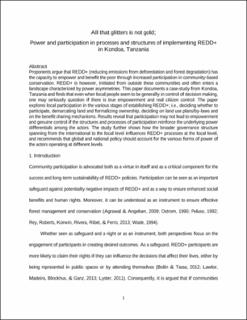| dc.contributor.author | Nantongo, Mary Gorret | |
| dc.contributor.author | Vatn, Arild | |
| dc.contributor.author | Vedeld, Pål Olav | |
| dc.date.accessioned | 2021-12-09T09:19:04Z | |
| dc.date.available | 2021-12-09T09:19:04Z | |
| dc.date.created | 2018-12-13T14:32:09Z | |
| dc.date.issued | 2018 | |
| dc.identifier.citation | Forest Policy and Economics. 2018, 100 44-54. | |
| dc.identifier.issn | 1389-9341 | |
| dc.identifier.uri | https://hdl.handle.net/11250/2833525 | |
| dc.description.abstract | Proponents argue that REDD+ (reducing emissions from deforestation and forest degradation) has the capacity to empower and benefit the poor through increased participation in community-based conservation. REDD+ is however, initiated from outside these communities and often enters a landscape characterized by power asymmetries. This paper documents a case-study from Kondoa, Tanzania and finds that even when local people seem to be generally in control of decision making, one may seriously question if there is true empowerment and real citizen control. The paper explores local participation in the various stages of establishing REDD+; i.e., deciding whether to participate, demarcating land and formalizing ownership, deciding on land use plans/by-laws and on the benefit sharing mechanisms. Results reveal that participation may not lead to empowerment and genuine control if the structures and processes of participation reinforce the underlying power differentials among the actors. The study further shows how the broader governance structure spanning from the international to the local level influences REDD+ processes at the local level, and recommends that global and national policy should account for the various forms of power of the actors operating at different levels. | |
| dc.description.abstract | All that glitters is not gold; Power and participation in processes and structures of implementing REDD+ in Kondoa, Tanzania | |
| dc.language.iso | eng | |
| dc.title | All that glitters is not gold; Power and participation in processes and structures of implementing REDD+ in Kondoa, Tanzania | |
| dc.type | Peer reviewed | |
| dc.type | Journal article | |
| dc.description.version | acceptedVersion | |
| dc.source.pagenumber | 44-54 | |
| dc.source.volume | 100 | |
| dc.source.journal | Forest Policy and Economics | |
| dc.identifier.doi | 10.1016/j.forpol.2018.10.011 | |
| dc.identifier.cristin | 1642772 | |
| dc.relation.project | Norges forskningsråd: 230296 | |
| cristin.unitcode | 192,13,1,0 | |
| cristin.unitname | Institutt for internasjonale miljø- og utviklingsstudier | |
| cristin.ispublished | true | |
| cristin.fulltext | postprint | |
| cristin.qualitycode | 1 | |
